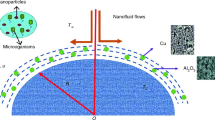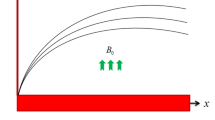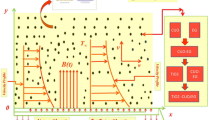Abstract
Significant applications of chemical reaction in flow using a curve sheet include metabolic, plastic extrusion and biochemical engineering. A few instances include the management of moisture and temperature supplies during an agricultural fair and the transmission of energy in a drizzly cooling tower. The current study aims to examine the heat and mass transmission for Darcy–Forchheimer flow induced by the curved stretch surface looped in a circle of radius \(R\). The flow is influenced by heat generation and thermal radiation with the effects of chemical reactions. Kerosene oil (KO) is used as the base fluid while three different types of nanoparticles, \({\text{GO}}, \,{\text{ZrO}}_{2}\) and \({\text{SiO}}_{2}\) are mixed with it. Convective heat conditions are incorporated in this model. A curvilinear coordinates system is studied to build the mathematical model of the flow condition under certain assumptions and then solved using the bvp4c approach in MATLAB. The effects of physical and geometrical characteristics relevant to this analysis on dimensionless physical quantities of interest are discussed using the necessary graphs and tables. According to the results, the Darcy–Forchheimer and porosity parameters caused a fall in the velocity profile, whereas the curvature parameter was found to cause an enhancement in the velocity profile. Our finding exhibits that \({\text{GO}}\) has a greater influence on \({\text{ZrO}}_{2} \;{\text{and}}\;{\text{SiO}}_{2}\). Thermal distribution augments with growth in radiative flow and Biot number while has declined with the upsurge in curvature factor. Growth in curvature factor has supported the behavior of concentration distribution and has been opposed by an upsurge in chemically reactive factor and Schmidt number. A comparison of the results obtained here with those that have already been published in the relevant literature has been made with outstanding achievement.








Similar content being viewed by others
Data availability
All data used in this manuscript have been presented within the article.
Abbreviations
- \({\text{Pr}}\) :
-
Prandtl number, (Dimensionless)
- \({\text{Rd}}\) :
-
Radiation parameter, (Dimensionless)
- \({K}^{*}\) :
-
Mean absorption, (Dimensionless)
- \({\text{Sc}}\) :
-
Schmidt number, (Dimensionless)
- \(\boldsymbol{\alpha }\) :
-
Curvature parameter, (Dimensionless)
- \({\text{Fr}}\) :
-
Forchheimer number, (Dimensionless)
- \({\varvec{\lambda}}\) :
-
Porosity parameter, (Dimensionless)
- \({\text{Rd}}\) :
-
Thermal radiation, (Dimensionless)
- \({{\text{Bi}}}_{1}\) :
-
Biot number, (Dimensionless)
- \({\epsilon }_{1}\) :
-
Heat source/sink parameter, (Dimensionless)
- \({{\text{Nu}}}_{{\text{s}}}\) :
-
Nusselt number, (Dimensionless)
- \({{\text{Sh}}}_{{\text{s}}}\) :
-
Sherwood number, (Dimensionless)
- \({\text{Kr}}\) :
-
Chemical reaction parameter, (Dimensionless)
- \(F^{\prime}\) :
-
Velocity, (Dimensionless)
- \(\vartheta \) :
-
Dimensionless temperature field, (Dimensionless)
- \(\phi \) :
-
Dimensionless concentration field, (Dimensionless)
- \({{\text{Cf}}}_{{\text{s}}}\) :
-
Skin friction coefficient, (Dimensionless)
- \({\varphi }_{1}\) :
-
Nanoparticle volume fraction silicon dioxide (\({{\text{SiO}}}_{2}\)), (-)
- \({\varphi }_{2}\) :
-
Nanoparticle volume fraction graphene oxide (Go), (-)
- \({\varphi }_{3}\) :
-
Nanoparticle volume fraction of zirconium dioxide \({{\text{ZrO}}}_{2}\), (-)
- R :
-
Radius, (m)
- \({\tau }_{{\text{w}}}\) :
-
Wall shear stress, (\(\mathrm{kg }\,{{\text{m}}}^{-1} \,{{\text{s}}}^{-2}\))
- \(u,v\) :
-
Component of velocity, (\(\mathrm{m }\,{{\text{s}}}^{-1}\))
- \({c}_{{\text{p}}}\) :
-
Specific heat, (\( {\text{J}}\;({\text{kg}})^{{ - 1}}\, {\text{K}}^{{ - 1}} \))
- \(g\) :
-
Acceleration due to gravity, (\(\mathrm{m }\,{{\text{s}}}^{-2}\))
- \({\mu }_{{\text{f}}}\) :
-
Dynamic viscosity, (\({\text{kg}}\,{({\text{ms}})}^{-1}\))
- \({v}_{{\text{f}}}\) :
-
Kinematic viscosity of KO, (\({{{\text{m}}}^{2}\,\mathrm{ s}}^{-1}\))
- \({\alpha }_{{\text{f}}}\) :
-
Thermal diffusivity, (\({{{\text{m}}}^{2}\,\mathrm{ s}}^{-1}\))
- \(k\) :
-
Thermal conductivity, (\(\mathrm{kgm }\,\,{{\text{K}}}^{-1} \,{{\text{s}}}^{-3}\))
- \({\rho }_{{\text{f}}}\) :
-
Density of nanofluid, (\(\mathrm{kg }\,{{\text{m}}}^{-3}\))
- \({\sigma }^{*}\) :
-
Stefan–Boltzmann constant, (\({{\mathrm{W\,m}}^{-1}\,\mathrm{ K}}^{-1}\))
- \(T\) :
-
The temperature of the fluid, (\(K\))
- \({T}_{{\text{w}}}\) :
-
Wall temperature, (\({\text{K}}\))
- \({T}_{\infty }\) :
-
Ambient temperature, (\({\text{K}}\))
- \({T}_{{\text{f}}}\) :
-
Surface heat, (\({\text{K}}\))
- \(h\) :
-
Coefficient of heat transfer, (\({\mathrm{W \,k}}^{-1}\,{\mathrm{ m}}^{-2}\))
- \({q}_{{\text{r}}}\) :
-
Radiative heat flux, (\( {\text{W}}\,({\text{m}})^{{ - 2}} \))
- \(P\) :
-
Pressure, (\({\mathrm{N\, m}}^{-2}\))
- \({\mu }_{{\text{thnf}}}\) :
-
Dynamic viscosity of KO, (\( {\text{kg}}\,({\text{ms}})^{{ - 1}} \))
- \({v}_{{\text{thnf}}}\) :
-
Kinematic viscosity of KO, (\({{{\text{m}}}^{2}\,\mathrm{ s}}^{-1}\))
- \({\alpha }_{{\text{thnf}}}\) :
-
Thermal diffusivity of KO, (\({{{\text{m}}}^{2}\,\mathrm{ s}}^{-1}\))
- \({k}_{{\text{thnf}}}\) :
-
Thermal conductivity of KO, (\(\mathrm{kg\,m }\,\,{{\text{K}}}^{-1} {{\text{s}}}^{-3}\))
- \({\rho }_{{\text{thnf}}}\) :
-
Density of Nanofluid of KO, (\(\mathrm{kg }\,{{\text{m}}}^{-3}\))
- \({{(C}_{{\text{p}}})}_{{\text{thnf}}}\) :
-
Specific heat capacity of KO, (\({\text{kg}}\,{\mathrm{ m}}^{-3}\))
- \({\mu }_{{\text{hnf}}}\) :
-
Dynamic viscosity of KO, (\( {\text{kg}}\,({\text{ms}})^{{ - 1}} \))
- \({v}_{{\text{hnf}}}\) :
-
Kinematic viscosity of KO, (\({{{\text{m}}}^{2}\,\mathrm{ s}}^{-1}\))
- \({\alpha }_{{\text{hnf}}}\) :
-
Thermal diffusivity of KO, (\({{{\text{m}}}^{2}\,\mathrm{ s}}^{-1}\))
- \({k}_{{\text{hnf}}}\) :
-
Thermal conductivity of KO, (\(\mathrm{kg\,m }\,{{\text{K}}}^{-1}\,{\mathrm{ s}}^{-3}\))
- \({\rho }_{{\text{hnf}}}\) :
-
Density of nanofluid of KO, (\({\text{kg}}\,{\mathrm{ m}}^{-3}\))
- \({{(C}_{{\text{p}}})}_{{\text{hnf}}}\) :
-
Specific heat capacity of KO, (\({\text{kg}}\,{\mathrm{ m}}^{-3}\))
- \(f\) :
-
Fluid base
- \({\text{thnf}}\) :
-
Trihybrid nanofluid
- \({\text{hnf}}\) :
-
Hybrid nanofluid
- \({\text{nf}}\) :
-
Nanofluid
- \(s\) :
-
Solid phase
- PDE:
-
Partial differential equation
- ODE:
-
Ordinary differential equation
References
Mouna HB, Tawfeeq AA, Amor R, Saeed R, Iskander T. High-efficiency Perovskite photovoltaic system performance by molecular dynamics method: optimizing electron transport thicknesses, hole transport, and anti-reflector layers of the sustainable energy materials. Eng Ana Bound Elements. 2023;150:120–6.
Sathish TS, Uma M, Balaji V, Nirupama P, Hitesh P, Zhixiong L, Iskander T. Coastal pollution analysis for environmental health and ecological safety using deep learning technique. Adv Eng Softw. 2023;2023:103441. https://doi.org/10.1016/j.advengsoft.2023.103441.
Mahum R, Aun I, Mohammed AEM, Mohamed S, Iskander T, Saamia B, Asad M, Muhammad A. A robust framework for severity detection of knee osteoarthritis using an efficient deep learning model. Int J Pattern Recog Artif Int. 2023;37:2352010. https://doi.org/10.1142/S0218001423520109.
Banawas S, Talib KI, Iskander T, Quynh HL. Reinforced calcium phosphate cements with zinc by changes in initial properties: a molecular dynamics simulation. Eng Ana Boundary Elements. 2023;147:11–21. https://doi.org/10.1016/j.enganabound.2022.11.033.
Wei W, Iskander T, Mustafa M, Mohammad S, Li Z. Numerical simulation to model the effect of injection velocity on the thermo-hydraulic behavior of the microchannel fluid flow via navier-stokes equations joined with the slip velocity boundary condition. Eur Phys J Plus. 2022;137:1363. https://doi.org/10.1140/epjp/s13360-022-03565-y.
Hanif H, Shafie S. Impact of Al2O3 in electrically conducting mineral oil-based maxwell nanofluid: application to the petroleum industry. Fractal Fract. 2022;6:180.
AlDosari SM, Saeed B, Hevi SG, Iskander T, Quynh HL. Drug release using nanoparticles in the cancer cells on 2-D materials in order to target drug delivery: a numerical simulation via molecular dynamics method. Eng Ana Boundary Elemen. 2023;2023(148):34–40. https://doi.org/10.1016/j.enganabound.2022.12.020.
Choi SUS. Enhancing thermal conductivity of fluids with nanoparticles. In: Siginer DA, Wang HP, editors. Developments and Applications of Non-Newtonian Flows. New York: ASME; 1995. p. 66–99.
Acharya N, Mabood F, Shahzad SA, Badruddin IA. Hydrothermal variations of radiative nanofluid flow by the influence of nanoparticles diameter and nanolayer. Int Comm Heat Mass Transf. 2022;130: 105781.
Varun KR, Gunderi D, Naveen KP, Punith GR, Prasannakumara BC. Modeling and theoretical investigation on Casson nanofluid flow over a curved stretching surface with the influence of magnetic field and chemical reaction. Int J Comp Methods Eng Sci Mech. 2022;23:12–9.
Shahid A, Bhatti MM, Ellahi R, Mekheimer KS. Numerical experiment to examine activation energy and bi-convection Carreau nanofluid flow on an upper paraboloid porous surface: application in solar energy. Sustain Energ Techn Assess. 2022;52: 102029.
Bhatti MM, Arain MB, Zeeshan A, Ellahi R, Doranehgard MH. Swimming of Gyrotactic microorganism in MHD Williamson nanofluid flow between rotating circular plates embedded in porous medium: application of thermal energy storage. J En Stor. 2022;45: 103511.
Mandev E, Manay E, Rahimpour S, Mohammadzadeh A, Şahin B, Afshari F, Teimuri-Mofrad R. Surface modification of Fe3O4 nanoparticles for preparing stable water-based nanofluids. Heat Trans Res. 2022;18:39–55.
Gülmüş B, Muratçobanoğlu B, Mandev E, Afshari F. Experimental and numerical investigation of flow and thermal characteristics of aluminum block exchanger using surface-modified and recycled nanofluids. Int J Num Method Heat Fluid Flow. 2023;33:2685–709.
Chu YM, Bashir S, Ramzan M, Malik MY. Model-based comparative study of magnetohydrodynamics unsteady hybrid nanofluid flow between two infinite parallel plates with particle shape effects. Math Methods Appl Sci. 2022;46:11568–82.
Wang J, Xu YP, Qahiti R, Jafaryar M, Alazwari MA, Abu-Hamdeh NH, Issakhov NH, Selim MM. Simulation of hybrid nanofluid flow within a microchannel heat sink considering porous media analyzing CPU stability. J Pet Sci Eng. 2022;208: 109734.
Khan A, Saeed A, Tassaddiq A, Gul T, Kumam P, Ali I, Kumam W. Bio-convective and chemically reactive hybrid nanofluid flow upon a thin stirring needle with viscous dissipation. Sci rep. 2021;11:8066.
Zhang L, Bhatti MM, Michaelides EE, Marin M, Ellahi R. Hybrid nanofluid flow towards an elastic surface with tantalum and nickel nanoparticles, under the influence of an induced magnetic field. Eur Phys J S Topic. 2022;2022:1–13.
Ojjela O. Numerical investigation of heat transport in Alumina-Silica hybrid nanofluid flow with modeling and simulation. Math Comp Sim. 2022;193:100–22.
Rauf A, Shah NA, Botmart T. Hall current and morphological effects on MHD micropolar non-Newtonian tri-hybrid nanofluid flow between two parallel surfaces. Sci Rep. 2022;12(1):16608.
Guedri K, Khan A, Sene N, Raizah Z, Saeed A, Galal AM. Thermal flow for radiative ternary hybrid nanofluid over nonlinear stretching sheet subject to Darcy–Forchheimer phenomenon. Math Prob Eng. 2022;2022:3429439.
Algehyne EA, Alrihieli HF, Bilal M, Saeed A, Weera W. Numerical approach toward ternary hybrid nanofluid flow using variable diffusion and non-Fourier’s concept. ACS Omega. 2022;7(33):29380–90.
Shamshuddin MD, Akkurt N, Saeed A, Kumam P. Radiation mechanism on dissipative ternary hybrid nanoliquid flow through rotating disk encountered by Hall currents: HAM solution. Alex Eng J. 2023;65:543–59.
Bilal M, Ullah I, Alam MM, Weera W, Galal AM. Numerical simulations through PCM for the dynamics of thermal enhancement in ternary MHD hybrid nanofluid flow over plane sheet, cone, and wedge. Symmetry. 2020;14(11):2419.
Sharma RP, Madhukesh JK, Shukla S, Fehmi Gamaoun BC. Prasannakumara numerical study of the thermophoretic velocity of ternary hybrid nanofluid in a microchannel bounded by the two parallel permeable flat plates. J Therm Anal Calorim. 2023;148:14069–80.
Madhukesh JK, Ramesh GK, Chavaraddi KB, Aly EH, Almutairi B, Shah NA. Impact of active and passive control of nanoparticles in ternary nanofluids across a rotating sphere. Results Phys. 2023;54:107069.
Esfe MH, Toghraie D, Esfandeh S, Alidoust S. Measurement of thermal conductivity of triple hybrid water based nanofluid containing MWCNT (10%)-Al2O3 (60%)-ZnO (30%) nanoparticles. Colloids Surf A Physicochem Eng Asp. 2022;647:129083.
Nazir U, Saleem S, Al-Zubaidi A, Shahzadi I, Feroz N. Thermal and mass species transportation in tri-hybridized Sisko martial with heat source over vertical heated cylinder. Int Comm Heat Mass Trans. 2021;2021:106003.
Cao W, Animasaun IL, Yook SJ, Oladipupo VA, Ji X. Simulation of the dynamics of colloidal mixture of water with various nanoparticles at different levels of partial slip: ternary-hybrid nanofluid. Int Comm Heat Mass Trans. 2022;135:106069.
Darcy H. Les fontainespubliques de la ville de Dijon, Victor Dalmont. Paris: The Flow of Homogeneous Fluids Through Porous Media; 1856.
Forchheimer PH. Wasserbewegungdurchboden. Zeitschrift Des Vereines DeutscherIngenieure. 1901;45(50):1781–8.
Muskat M. The flow of homogeneous fluids through porous media. Soil Sci. 1938;46(2):169.
Lee SL, Yang JH. Modeling of Darcy–Forchheimer drag for fluid flow across a bank of circular cylinders. Int J Heat Mass Transf. 1997;40(13):3149–55.
Ashraf W, Khan I, Andualem M. Thermal transport investigation and shear drag at solid–liquid interface of modified permeable radiative-SRID subject to Darcy–Forchheimer fluid flow composed by γ-nanomaterial. Scient Rep. 2022;12(1):3564.
Raja MAZ, Shoaib M, Zubair G, Khan MI, Gowda RP, Prasannakumara BC, Guedri K. Intelligent neuro-computing for entropy generated Darcy–Forchheimer mixed convective fluid flow. Math Comput Simul. 2022;201:193–214.
Jalili B, Mousavi A, Jalili P, Shateri A, Domiri GD. Thermal analysis of fluid flow with heat generation for different logarithmic surfaces. Int J Eng. 2022;35(12):2291–6.
Owhaib W, Al-Kouz W. Three-dimensional numerical analysis of flow and heat transfer of bi-directional stretched nanofluid film exposed to an exponential heat generation using modified Buongiorno model. Sci Rep. 2022;12(1):10060.
Hussain SM, Goud BS, Madheshwaran P, Jamshed W, Pasha AA, Safdar R, Arshad M, Ibrahim RW, Ahmad MK. Effectiveness of nonuniform heat generation (sink) and thermal characterization of a carreau fluid flowing across a nonlinear elongating cylinder: a numerical study. ACS Omega. 2022;7(29):25309–20.
Cui J, Razzaq R, Farooq U, Khan WA, Farooq FB, Muhammad T. Impact of non-similar modeling for forced convection analysis of nano-fluid flow over stretching sheet with chemical reaction and heat generation. Alex Eng J. 2022;61(6):4253–61.
Patel HR. Cross diffusion and heat generation effects on mixed convection stagnation point MHD Carreau fluid flow in a porous medium. Int J Amb Energ. 2022;43(1):4990–5005.
Ojemeri G, Hamza MM. Heat transfer analysis of Arrhenius-controlled free convective hydromagnetic flow with heat generation/absorption effect in a micro-channel. Alex Eng J. 2022;61(12):12797–811.
Saeed M, Berrouk AS, AlShehhi MS, AlWahedi YF. Numerical investigation of the thermohydraulic characteristics of microchannel heat sinks using supercritical CO2 as a coolant. J Supercrit Fluids. 2021;176: 105306.
Nasir S, Sirisubtawee S, Juntharee P, Berrouk AS, Mukhtar S, Gul T. Heat transport study of ternary hybrid nanofluid flow under magnetic dipole together with nonlinear thermal radiation. Appl Nanosci. 2022;12:2777–88. https://doi.org/10.1007/s13204-022-02583-7.
Maity S, Kundu PK. Magnetically driven chemically reactive Casson nanofluid flow over curved surface with thermal radiation. Heat Trans. 2022;51(6):4882–905.
Mishra A, Upreti H. A comparative study of Ag–MgO/water and Fe3O4–CoFe2O4/EG–water hybrid nanofluid flow over a curved surface with chemical reaction using Buongiorno model. Partial Diff Eq Appl Math. 2022;5: 100322.
Ragupathi P, Ahammad NA, Wakif A, Shah NA, Jeon Y. Exploration of multiple transfer phenomena within viscous fluid flows over a curved stretching sheet in the co-existence of gyrotactic micro-organisms and tiny particles. Mathematics. 2022;10(21):4133.
Fuzhang W, Anwar MI, Ali M, El-Shafay AS, Abbas N, Ali R. Inspections of unsteady micropolar nanofluid model over exponentially stretching curved surface with chemical reaction. Waves Random Complex Media. 2022;2022:1–22.
Sandeep N, Sulochana C, Ashwinkumar GP. Understanding the dynamics of chemically reactive Casson liquid flow above a convectively heated curved expanse. Proc Inst Mech Eng Part C J Mech Eng Sci. 2022;236(24):11420–30.
Gao F, Yu D, Sheng Q. Analytical treatment of unsteady fluid flow of nonhomogeneous nanofluids among two infinite parallel surfaces: collocation method-based study. Math. 2022;10(9):1556.
Hayat AU, Ullah I, Khan H, Weera W, Galal AM. Numerical simulation of entropy optimization in radiative hybrid nanofluid flow in a variable features Darcy–Forchheimer curved surface. Symmetry. 2022;14(10):2057.
Qian WM, Khan MI, Shah F, Khan M, Chu YM, Khan WA, Nazeer M. Mathematical modeling and MHD flow of micropolar fluid toward an exponential curved surface: heat analysis via ohmic heating and heat source/sink. Arab J Sci Eng. 2022;47(1):867–78.
Ali A, Jana RN, Das S. nanoliquid flow over an extending curved surface with slippage and convective heating. Heat Trans. 2021;50(3):2997–3020.
Abbas Z, Naveed M, Sajid M. Hydromagnetic slip flow of nanofluid over a curved stretching surface with heat generation and thermal radiation. J Mol Liq. 2016;215:756–62. https://doi.org/10.1016/j.molliq.2016.01.012.
Dawar A, Saeed I, Zahir S, Mahmuod SR. A passive control of casson hybrid nanofluid flow over a curved surface with alumina and copper nanomaterials: a study on sodium alginate-based fluid. J Mol Liq. 2023;382: 122018. https://doi.org/10.1016/j.molliq.2023.122018.
Dawar A, Islam S, Shah Z. A comparative analysis of the performance of magnetized copper–copper oxide/water and copper–copper oxide/kerosene oil hybrid nanofluids flowing through an extending surface with velocity slips and thermal convective conditions. Int J Ambient Energy. 2022;43(1):7330–48.
Nayak B, Mishra SR. Squeezing flow analysis of CuO–water and CuO–kerosene-based nanofluids: a comparative study. Pramana. 2021;95:1–8.
Hossain R, Azad AK, Hasan MJ, Rahman MM. Thermophysical properties of Kerosene oil-based CNT nanofluid on unsteady mixed convection with MHD and radiative heat flux. Eng Sci Tech An Int J. 2022;35:101095.
Jamshed W, Nisar KS, Ibrahim RW, Tayyaba Mukhtar V, Vijayakumar FA. Computational frame work of Cattaneo–Christov heat flux effects on engine oil based Williamson hybrid nanofluids: a thermal case study. Case Stud Thermal Eng. 2021;26:101179.
Ahmad F, Abdal S, Ayed H, Hussain S, Suleman Salim A, Almatroud O. The improved thermal efficiency of Maxwell hybrid nanofluid comprising of graphene oxide plus silver/kerosene oil over stretching sheet. Case Stud Thermal Eng. 2021;27:10125.
Yaseena M, Kumara M, Rawat SK. Assisting and opposing flow of a MHD hybrid nanofluid flow past a permeable moving surface with heat source/sink and thermal radiation. Partial Differ Equ Appl Math. 2021;4: 100168.
Aly EH, Pop I. MHD flow and heat transfer over a permeable stretching/shrinking sheet in a hybrid nanofluid with a convective boundary condition. Int J Numer Meth Heat Fluid Flow. 2019;29(9):3012–38.
Acknowledgements
The authors extend their appreciation to the Deanship of Scientific Research at King Khalid University, Abha, Saudi Arabia, for funding this work through the Research Group Project under Grant Number (RGP.2/505/44).
Author information
Authors and Affiliations
Corresponding author
Ethics declarations
Conflict of interest
The authors have no conflict of interest.
Additional information
Publisher's Note
Springer Nature remains neutral with regard to jurisdictional claims in published maps and institutional affiliations.
Rights and permissions
Springer Nature or its licensor (e.g. a society or other partner) holds exclusive rights to this article under a publishing agreement with the author(s) or other rightsholder(s); author self-archiving of the accepted manuscript version of this article is solely governed by the terms of such publishing agreement and applicable law.
About this article
Cite this article
Ali, F., Mahnashi, A.M., Hamali, W. et al. Numerical scrutinization of Darcy–Forchheimer flow for trihybrid nanofluid comprising of \({\text{GO}} + {\text{ZrO}}_{2} + {\text{SiO}}_{2}\)/kerosene oil over the curved surface. J Therm Anal Calorim (2024). https://doi.org/10.1007/s10973-024-13103-w
Received:
Accepted:
Published:
DOI: https://doi.org/10.1007/s10973-024-13103-w




